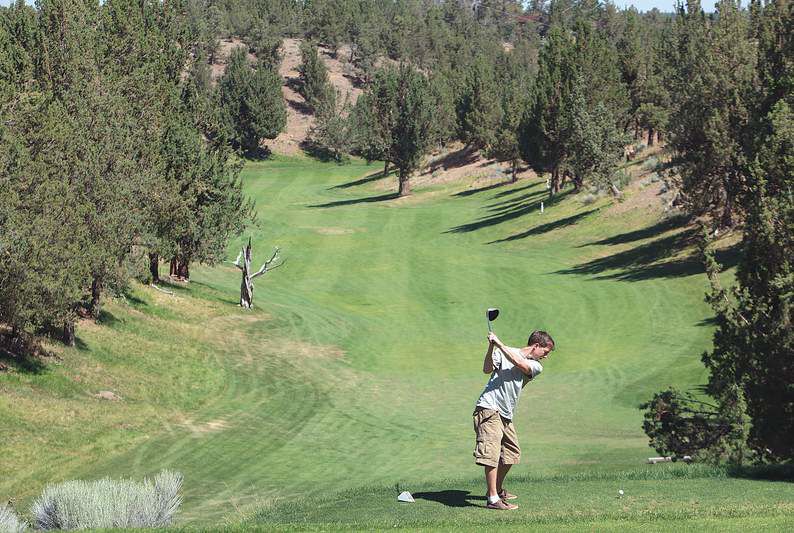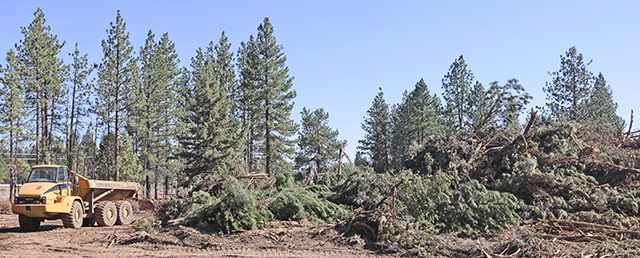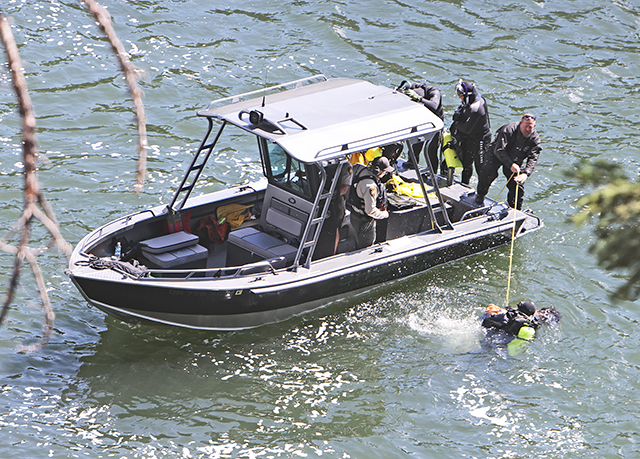Eagle Crest: Resort Course
Published 5:00 am Wednesday, August 3, 2011

- Eli Ritchie, 23, hits his drive on the par-5 second hole at Eagle Crest Resort’s Resort Course, Friday.
Editor’s note: This is another in a seasonlong series visiting each public and semiprivate golf course in Central Oregon.
REDMOND —
Trending
At this golf course, if you’re not in love with the view, just wait until your next shot.
I’m talking about the Resort Course at Eagle Crest Resort, the three-track facility’s original golf course.
Take the Resort Course’s opening set of holes. The par-4 first hole is wide-open and flat. The second hole is a tough par 5 played downhill into a razor-thin, juniper-lined canyon that doglegs right into a tiny green.
No two consecutive holes could play more differently. And the par-4 fourth hole kicks off a more open stretch of holes that lasts until the turn.
My golf partner, a visitor from Redmond, Wash., who joined my group on a recent sun-drenched morning, took notice as we popped up over a hill and laid eyes on the suddenly open course revealed on the fourth hole.
“Man, it’s a whole different world again,” he proclaimed as we looked out into a meadow that unmasks the majority of the next several holes.
Trending
Such dramatic shifts in style are frequent at the Resort Course, which plays not at all like Eagle Crest’s Ridge or Challenge courses.
Designed by Gene “Bunny” Mason — the late longtime Central Oregon golf pro who also designed notable Central Oregon golf courses such as Awbrey Glen in Bend and Black Butte Ranch’s Glaze Meadow — the Resort Course opened in 1986.
The course takes a unique route through a small canyon, into flatland, through residential areas, into a dense batch of junipers, and back out to an open finish.
The layout gives a golfer the feeling of playing a different course seemingly every few holes.
That kind of course can be fun, depending on how much variety a golfer likes in his or her round. And on such a course, golfers need to stay on their toes.
How so?
At a relatively short 6,704 yards, this course is going to tempt big hitters to go for too much. And that can make the Resort Course, which is not particularly difficult for skilled golfers, play much harder than it really is.
The second hole is a good example. It’s tempting to look from the tee box down the canyon that shapes the fairway and figure that, at 549 yards, the green is easily reachable in two shots.
But the tee shot must travel significantly farther than 300 yards — which is possible with such a steep downhill shot — for any chance to reach the green in two. Anything shorter on the severe dogleg right, and the second shot will be blocked by a hill lined with junipers that cuts off any chance of reaching the green.
By taking driver, all a golfer has done is increase the chance of hitting into the hole’s only trouble: the tree-covered hills to the left and right of the fairway.
Besides, the Resort Course offers plenty of chances to play for birdie on the more-open holes that make up most of the final six of the front nine.
The first five holes of the back nine close the course again, and make up the strongest run of holes on the course.
“It’s like three golf courses,” said the Washington golfer as we walked toward the tee box of No. 15, a narrow par-5 hole lined with junipers. “You have the pasture, the gully, and now this.”
Little did he know then that the course was about to change again on the 16th hole, starting a three-hole finish that feels quite different from the earlier holes on the back nine.
For all the changes, though, the Resort Course remains a position golf course throughout the round. And golfers able to set up short approaches, making it easier to hit the correct tiers on the often undulating greens, will find success at the Resort Course.
But pay attention.
What worked on the last hole might not work again on the next. And that kind of variety is usually enough to keep any golfer interested.
Difficulty of
course
Highly skilled golfers should have little trouble navigating the relatively short 6,704-yard Resort Course.
Accuracy should be tested on certain holes, such as the razor-thin par-5 second hole or a run of holes on the back nine. But about half of the Resort Course’s holes are wide-open with little interference from fairway bunkers, juniper trees or water hazards, making birdie an often obtainable goal.
Better players will still find a challenge on approach shots, where the Resort Course’s deep greenside bunkers, relatively small greens, and occasional severe undulations can wreak havoc on a scorecard.
With few fairway bunkers and little water in play (the par-4 eighth and par-4 17th have the only in-play ponds), the Resort Course is friendly to average and novice golfers.
Lesser-skilled golfers will still be forced to play with some accuracy to avoid greenside bunkers and find a place on the course’s small greens.
Favorite hole
The par-4 17th hole is one of several holes at the Resort Course that force a golfer to throttle down from the tee.
Though No. 17 plays only 388 yards from the back tees, two menacing ponds and two fairway bunkers squeeze the fairway about 230 yards from the tee. That leaves a golfer the choice of hitting a fairway wood and leaving a longer approach, or hitting a driver to set up a short approach while at the same time bringing water into play.
The approach to the two-tiered green is crucial. The green is narrow, and a golfer must find the correct tier for a decent chance at a two-putt. Anything that drifts long or left can find its way into one of two greenside bunkers.
Strategy
Long hitters will be tempted to go for too much because of the Resort Course’s relatively short distance, making the course play harder than it really is.
A good score might depend on knowing when to go for it, and when to play conservatively and aim for the middle of the fairway. Catching the correct angles into the green and avoiding the sticky rough — brought into play more on certain holes where the fairway chokes in to create smaller landing areas — are more important than a shorter approach.
The Resort Course’s small greens are receptive, so golfers can be aggressive on approach shots. But pay particular attention to the course’s undulating greens. Landing your ball on a tier other than the one on which the pin is located can make a two-putt a challenge.
Extras
Eagle Crest Resort has everything a golfer could want, including a real-grass 18-hole putting course, two driving ranges, several practice greens, a clubhouse, a restaurant, and a golf academy.
The Resort Course, which is located across Cline Falls Road from the Challenge and Ridge courses, offers a particularly convenient practice area. The large short-game practice area has two bunkers and a green. The area is just a few feet from the driving range.
Mere steps from the first tee, which runs adjacent to the driving range, rests a full practice putting green.
In other words, a golfer could work on every facet of the game without walking more than 100 feet.
The Resort Course’s small clubhouse does not include a restaurant, but it does have a snack bar serving standard fare such as sandwiches and hot dogs.
Value
Morning tee times cost $69 per golfer, which is the same price as Eagle Crest’s more popular (at least among locals) Ridge Course.
The Resort Course’s twilight rate begins early — at noon — when the price drops to $49.
Junior golfers get a particularly good deal at Eagle Crest. Before 3 p.m. juniors (age 17 and younger) can play the course for half price. After 3 p.m. juniors accompanied by an adult play for free, and unaccompanied juniors can play for $10.
The basics
General information about Eagle Crest Resort’s Resort Course:
Number of holes: 18
Status: Open seasonally
Location: 1522 Cline Falls Road, Redmond
Tee times: 541-923-4653
Course stats: Par 72, 6,704 yards
Green fees: Through Oct. 14, $69 daily, $49 after noon; Oct. 15-Nov. 14, $50 daily
Power cart: $16
Director of golf: Ron Buerger
Director of instruction: Tam Bronkey
Course designer: Gene “Bunny” Mason (1986)
Extras: Real-grass 18-hole putting course, two driving ranges, several practice greens, clubhouse, restaurant, golf academy
Website: www.eagle-crest.com
Scorecard
Breaking down the course
A closer look at Eagle Crest Resort Course.
Difficulty
Not a particularly difficult course for highly skilled golfers, who will find plenty of birdie opportunities on the 6,704-yard layout. But some holes will test a golfer’s accuracy. Novices will find a comfortable place to play that will not be overly punitive.
Strategy
Longer hitters should be careful not to overreach on some of the Resort Course’s narrower holes. Avoid the sticky rough, which makes clean contact a challenge. Finding the correct tier is paramount on the course’s relatively small, undulating putting surfaces.
Extras
The Resort Course’s short-game practice area, driving range and practice putting green are all within a few feet of the course’s first tee. The short-game area is particularly roomy, with two large bunkers and a green. The course’s small clubhouse has a snack bar.
Scorecard
The scorecard for Eagle Crest Resort’s Resort Course:
Hole Par Yardage
No. 1 Par 4 369 yards
No. 2 Par 5 481 yards
No. 3 Par 3 150 yards
No. 4 Par 4 365 yards
No. 5 Par 4 436 yards
No. 6 Par 5 588 yards
No. 7 Par 3 202 yards
No. 8 Par 4 409 yards
No. 9 Par 4 357 yards
Out Par 36 3,357 yards
No. 10 Par 4 385 yards
No. 11 Par 5 549 yards
No. 12 Par 3 204 yards
No. 13 Par 4 429 yards
No. 14 Par 4 334 yards
No. 15 Par 5 504 yards
No. 16 Par 3 204 yards
No. 17 Par 4 388 yards
No. 18 Par 4 350 yards
In Par 36 3,347 yards






